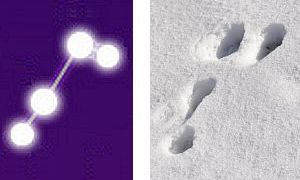Wikipedia
R.H. Allen:
Star Names
Ian Ridpath:
Star Tales
Universe Guide
Sea and Sky:
The Constellations
IAU
Map
NASA:
Constellations
|
Wikipedia |
R.H. Allen: Star Names |
Ian Ridpath: Star Tales |
Universe Guide |
Sea and Sky: The Constellations |
IAU Map |
NASA: Constellations |


|
|
Star LoreScorpiusPart 3 - Africa, Australia and Americas |
|


 Nanaboujou
Nanaboujou |
Scorpius is one of the most prominent and most recognizable constellations in our summer
sky. Located on the celestial equator, the constellation is visible throughout the world. The interpretations of the constellation are as diverse as the cultures touched by it. |


Africa |
|
|
ǀXu
The ǀXu of southern Africa call Antares (α Sco)
the Fire-Finishing Star. It has a reddish colour, and at certain times of the year it sets very late at night, when
the camp fires have died down.
|


|
|
Khoe Khoe
The Khoe Khoe people in southwestern Africa call the binary system of
μ1 and
μ2 Scorpii Xami Di Mura, meaning "eyes of the lion."
|
 Lion in a rock engraving
Lion in a rock engravingin Twyfelfontein, Namibia Source: worldatlas.com |


Australia |
|
|
Boorong
The Boorong of north-Western Victoria call Antares (α Scorpii) Djuit. He is the son of Marpeankurrk,
which is Arcturus (α Boötis). |
 Red-rumped parrot
Red-rumped parrotSource: Wikipedia |

The two stars at the end of the scorpio's tail, Shaula (λ Scorpii) and
Lesath (υ Scorpii) are a male and a female Kestrel
(a kind of falcon), called Karik Karik.
 The stars are directly overhead in the early evening in August, when the kestrel start laying their eggs.  Source: Stanbridge |
 Australian Kestrel
Australian KestrelSource: Wikipedia |


|
|
Torres Strait Islanders
Tagai is a large constellation made up of Lupus, Centaurus, Crux, Corvus, with part of Hydra and one of the stars of Ara.
In the culture of the Torres Strait Islanders, Tagai is a creation hero. He is depicted as a fisherman standing in a canoe
outlined by the stars of Scorpius.
|
 Tagai constellation Source: Wikipedia |

After the onslaught, in an uncanny resemblance to the Greek myth about Orion and the Scorpion,
Tagai and Kareg were placed far away from their former mates in a canoe outlined by the stars of Scorpius.
 Kareg is personified as Antares (α Scorpii), the bright red star sitting at the stern of the canoe.  Kareg was an important part of the Islander's agricultural calendar. The star's heliacal rising marked the time at which a little red bug called Moramor was going to attack the Yam plants.  Sources: deadlystory.com, Wikipedia, Tommy Pau, Hamacher et al.: Astronomy and Music in the Torres Strait, Folk-Lore Quarterly, Vol. I, 1890 |

|


|
|
Wangaibon
The Wangaibon in New South Wales tell a story about Antares (α Scorpii):
|

|


|
|
Wardaman
The star ε Scorpii bore the traditional name Larawag in the culture of the Wardaman
people of the Northern territory of Australia, meaning "clear sighting."
|


|
|
Warnindhilyagwa
The Warnindhilyagwa have a special meaning for the two stars at the very tip of the Scorpion's "stinger."
|


|
|
Yolngu
The people of Arnhem Land saw a crocodile called Ingalpir in the constellation we know as
Scorpius.
|

|


Americas |
|
|
Aztecs
McIvor sees evidence
of a rattlesnake as an Aztec constellation created out of stars from Ophiuchus and
Scorpius.
|
 Aztec Snake
Aztec SnakeSource: National Museum of Anthropology, Mexico City |


|
|
Cherokee
To the Cherokee, Sirius (α CMa) and
Antares (α Sco) are the dog stars that guard the end of the "Path of Souls", the
Milky Way. Sirius
in the winter sky guards the eastern end, while Antares in the summer sky guards the eastern end.
|

|


|
|
Cree
The first rising of Serpens in early summer signaled the arrival of the thunderstorm season.
The Cree people in what is now Canada saw a thunderbird in the northern stars of Scorpius and
the stars of Serpens.
|

 Thunderbird; © Native Skywatchers
Thunderbird; © Native Skywatchers |
 Thunderbird in a Cree petroglyph
Thunderbird in a Cree petroglyphSource: Atchakosuk |
 Thunderbird Constellation
Thunderbird ConstellationSource: Atchakosuk |


|
|
Inca
The Inca saw a jaguar in the constellation Scorpius and celebrated its return with a large ceremony.
|


|
|
Navajo
The constellation Átsé Etsoh, First Big One, depicts an elderly man with a cane and a basket of seeds. He rep-resents the wisdom of the elders
and the concept of Sá'áh Naagháii Bik'éh Hózhóón, the concept that "with old age comes happiness or contentment." His a cane provides
strength and stability.
|

|

The "Tail" of the Scorpion, consisting of λ, κ,
υ and ι1Scorpii
is called Gah Haat'e'ii, the "Rabbit Tracks."
 Navajo hunters used these stars to determine when the traditional hunting season would begin. As long as the "Rabit Tracks" remained up right in one position, young deer still depended on their mothers for nourishment and thus, deer were not hunted. on their mothers for nourishment. Only when ste stars tips to the east, it was deer hunting season.  Sources: Navajo Skies, grandcanyon.org, Navajo Astronomy |
 Gah Haat'e'ii - Rabbit Tracks
Gah Haat'e'ii - Rabbit Tracks
|

Also part of Scorpius is Kaalogi, the Butterfly constellation. It is adjacent to the First Big One, Átse’ Etsoh.
 It is considered a summer constellation, visible during the time when butterflies are migrating through the Navajo Nation.  Navajos, like other southwestern tribes, respect the butterfly as a symbol of the process of change, growth and regeneration.  Source: Navajo Skies |
 Kaalogi
© Melvin Bainbridge
Kaalogi
© Melvin Bainbridge
|


|
|
Ojibwe
On the Ojibwe Star Map, the constellation
Scorpius is depicted as Nanaboujou. He is a hero figure and a spirit that had many
excursions on Earth a long time ago. He helped the people by creating dry land after the last flood. The constellation shows Nanaboujou
shooting an arrow at the Great Panther, represented by the constellations Leo and
Cancer.
|

|


|
|
Pawnee
The Pawnee in the North American Plains, have a special meaning for the two stars at the very tip of the Scorpion's "stinger."
|

To the Pawnee, Antares was one of the four Direction Stars
that were used to align their dwellings.
 Pawnee earth lodges were dome-like, resembling the sky. The centers were held up with poles that were marked white, yellow, red, and black as colors of the stars.  White stood for Sirius (α CMa), yellow for Capella (α Aur), red for Antares (α Sco), and black for Vega (α Lyr).  Source: Pawnee Star People |
|



|
|
Flags and other National Symbols The center of the Brazilian flag presents the night sky as it would have been on November 15, 1889 at 08:30 over Rio de Janeiro. Each star corresponds to a Brazilian Federate Unit, sized in proportion relative to its geographic size. |

|

|
Antares (α Sco),
the brightest star in the constellation symbolizes the state of Piauí.
 The Flag of Piauí also features the star.
|
|

|
Graffias* (β Scorpii) symbolizes the state of Maranhão;
|  The Flag of Maranhão also features the star.
|
| 
|

| * In official literature, Brazil used the old Portugese name Graffias for β Scorpii, instead of the IAU designation Acrab. |

 Laraweg (ε Sco) symbolizes the state of Ceará. |
 Sargas (θ Sco) symbolizes the state of Alagoas. | |
 Apollyon (ι1 Sco) symbolizes the state of Sergipe. |
 Girtab (κ Sco) symbolizes the state of Paraíba. |
  Shaula (λ Sco) symbolizes the state of Rio Grande do Norte.  Xamidimura & Pipirima (μ Sco) symbolize the state of Pernambuco. Source:Wikipedia, Flags of the World - Astronomy of the Brazilian Flag |


 |
Back to Asia | Forward to Scorpius Myth Start Page |
 |


|
Back to Star Lore |
Back to Mythology |

Back to Scorpius |
Back to Space Page |
Back to English |
 Back to Start Page |